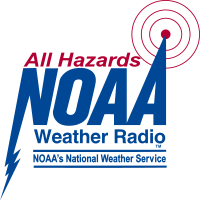Weather band
 |
|
| Type | Weather radio/civil emergency services |
|---|---|
| Branding | NOAA Weather Radio All Hazards |
| Country | |
| Availability | National (through radio transmitters, some commercial radio and television outlets, and Internet availability via streaming audio from other organizations) |
| Founded | 1954 (for aviation weather) 1958 (for general/marine weather) by National Oceanic and Atmospheric Administration |
| Slogan | "The Voice of the National Weather Service" |
| Radio stations | 1,032 VHF-FM transmitters |
| Owner | NOAA/National Weather Service |
|
Launch date
|
1950s (in selected cities) 1970s (nationwide) |
|
Official website
|
www |
NOAA Weather Radio (NWR; also known as NOAA Weather Radio All Hazards) is a network of radio stations in the United States that broadcast continuous weather information directly from a nearby (<40 miles) Weather Forecast Office of the service's operator, the National Weather Service (NWS), an agency of the National Oceanic and Atmospheric Administration (NOAA) within the United States Department of Commerce. NOAA Weather Radio broadcasts National Weather Service warnings, watches, forecasts, weather observations and other hazard information 24 hours a day. It also broadcasts alerts of non-weather emergencies such as national security, natural, environmental and public safety (such as an AMBER Alert) through the U.S. Federal Communications Commission's (FCC) Emergency Alert System.
Known as "The Voice of NOAA's National Weather Service", NOAA Weather Radio (NWR) is provided as a public service by the National Oceanic and Atmospheric Administration. By the end of 2014, NWR had about 1025 transmitters serving 95% of the United States' population, covering all 50 U.S. states, adjacent coastal waters, and the territories of Puerto Rico, the U.S. Virgin Islands, Guam, American Samoa and Saipan.
The radio service continuously transmits weather and marine forecasts (where applicable) and other related information. In addition, NWR works in cooperation with the FCC's Emergency Alert System (EAS), providing comprehensive severe weather alerts and civil emergency information. In conjunction with federal, state and local emergency managers and other public officials, NWR can broadcast alerts and post-event information for all types of hazards, including natural (such as earthquakes or avalanches), man-made (such as chemical releases or oil spills), technological (such as nuclear power plant emergencies) and public safety (such as "AMBER alerts" or 9-1-1 telephone outages). Many television stations which have the capability (both commercial and public) may simulcast a local NWR station's audio content on their second audio program channel if they are not carrying a program which features either a Spanish language translation or a Descriptive Video Service track for the visually impaired. Some digital subchannels which carry weather information may also have a local NWR audio feed airing in the background, while conventional television stations carry the audio during off-air periods while transmitting a test pattern, in lieu of a reference tone. Many cable television systems and some commercial television and radio stations will, during EAS activation, rebroadcast the audio of a warning message first heard on their local NWR station, to alert viewers of a severe weather event or civil emergency, usually with the issuance of a tornado warning or tornado emergency, especially in tornado-prone areas of the country. Listening to a NOAA Weather Radio station requires a special radio receiver or scanner capable of receiving at least one of seven specific channels within the frequency range of 162.4 MHz through 162.55 MHz, collectively known as "weather band". For example, a receiver that only tunes in standard FM or AM broadcast stations will not suffice. The seven FM channels, reserved by the U.S. Government for NWR broadcasts, are located within the larger "public service band", a VHF frequency band generally used by licensed government and public agencies and authorities for non-commercial, official two-way radio communications.
...
Wikipedia
